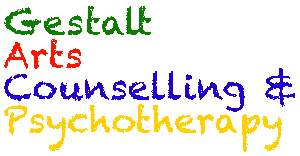During her summer training course in 2000 Violet Oaklander introduced our group to some enjoyable exploratory exercises based on the work of renowned musician Paul Winter (Oaklander, 2006.) Her steady presence as facilitator enabled us to safely explore our own relation to sound-making and to each other. Since then my work as a musician with Playback South, an improvisatory theatre company, has helped me continue experimenting with music–making, bringing it also into the foreground of my therapy practice (Blend, 2005, 2008).
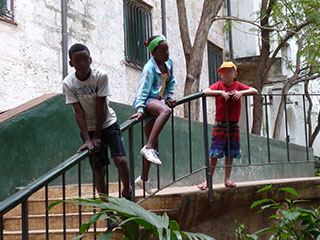 As a clinician working with children, adolescents and adults I offer a range of creative art modalities. I don’t usually suggest that we use music; but when a client expresses an interest in playing or makes a beeline for the instruments in my office I usually pick up the invitation.
As a clinician working with children, adolescents and adults I offer a range of creative art modalities. I don’t usually suggest that we use music; but when a client expresses an interest in playing or makes a beeline for the instruments in my office I usually pick up the invitation.
In this article I first refer to infant research into ‘communicative musicality’ (Trevarthen, 2009). Next I introduce some improvisation exercises by drummer John Stevens known as ‘click’ and ‘sustain’ pieces, which help participants develop their understanding of process and awareness of contact / withdrawal almost intuitively. An Oaklander schema for music-making is offered followed by a comment concerning rhythm and self-regulation. A concluding section on singing reminds us that music making is intrinsic to child development. The article ends with a vignette describing work with a teenager that incorporates voice and movement. Other vignettes illustrate work undertaken within a multi-disciplinary (NHS) Child and Adolescent Mental Health Service in Southern England.
Communicative musicality: improvising in infancy
Amongst mammals social play helps individuals to become community oriented (Burghardt, 2005). Music provides a means for young humans to express themselves from the earliest times. Foetal responses to musical experience in the womb (Lecanuet, 1996) and the richly musical and rhythmic conversations between mothers and tiny infants (Trevarthen and Malloch, 2003) suggest musicality begins preverbally. Communication between mothers and infants starts with ‘proto conversation’, a private inter-subjective language comprising an array of expressive made up sounds and gestures rooted in mutuality (Trevarthen, 2003). Here the caregivers, deploying accentuated high-pitched sounds interspersed with long glissandos, engage with their infants, making what is sometimes called ‘motherese’ (pp23 and 58). The result is a dialogue between mother and child.
Acoustic researcher Malloch (2009) has analysed the pitch and rhythm content of the proto conversations and gives the example of six-week-old Laura and her mother. When her mother exhorted: “Again. Come on then. That’s clever”. Baby Laura made two cooing sounds in response: “Ooo Ooo…”. Malloch’s analysis showed how mother and baby had created an elegant, metrical melody. This involved extended ‘duets’ that demonstrated pitch changes and turn–taking, leaving and then filling gaps in their song (Trevarthen, 2003). Such improvised exchanges between mother and infant follow a sequence of ‘Introduction, Development, Climax, Resolution’ (p60). They bear some resemblance to the Gestalt ‘Cycle of Experience’ (Clarkson,1993). First baby utters a sound “Oo, Oo” (Introduction/sensation) to which mother becomes aware and responds: (Development/mobilisation) “CLEVER GIRL – DO IT AGAIN!” The encounter builds towards a peak (Climax/full contact) “Oo oo, Blurg Cooo Cooo” – “OH, YOU’RE SO CLEVER!”, which is mutually enriching (Resolution/satisfaction), then both parties wind down (rest).
These duets introduce a ‘dynamic emotional syntax’ of phrases and feeling expressions, providing the foundation for baby’s later verbal expression (Trevarthen, 2003).
Malloch also studied the pitch and rhythm content of protoconversations between depressed mothers and their babies. By contrast these showed less variety, occupied a narrower dynamic range and were accompanied by less attuned relating. Why is this important? Stern suggests intersubjectivity is ‘a basic, primary motivational system’. Our continued engagement in ‘regulation of the intersubjective space’ remains vital (Stern, 2004, p97). Our survival as a species depends on our ability to attune to each other both musically and mimetically (Frohlich, 2009).
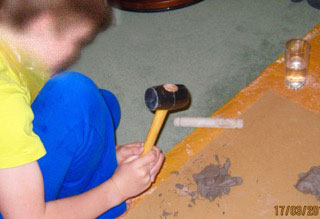 In clinical practice I see indications of attunement problems whenever I encounter children whose default approach to musical improvisation involves making sotto voce sounds. Conversely when other children incessantly seek to create noisy crescendos this suggests that their ways of relating interpersonally, of making contact, are out of balance.
In clinical practice I see indications of attunement problems whenever I encounter children whose default approach to musical improvisation involves making sotto voce sounds. Conversely when other children incessantly seek to create noisy crescendos this suggests that their ways of relating interpersonally, of making contact, are out of balance.
For example Omar, a timid boy aged seven, who had experienced school bullying, reached for some tiny tinkly bells, persistently declining to use the noisier drums, tambourines and cymbals in my office. Using the guitar I structured duets in which I could play a quieter accompanying role, helping Omar to explore other pitch registers and timbres more boldly. In turn this enabled him to become aware of different ways of engaging with the full range of available instruments. Omar joyfully discovered he could make the cymbals ring out (evoking a mock terror response in me which spurred him on to repeat my ‘torture’). He also found he could play simple tunes blowing into the melodica. When Omar progressed to beating the drums, his confidence and energy surged, enabling him to play the gamut of the percussion with confident verve and delight, thereby undoing his retroflection.
Oaklander has long emphasized the importance of helping children have experiences of their own mastery (Oaklander, 2007). This accords with findings from contempory neuroscience research. Trevarthen (Trevarthen, 2005), writing on companionship in infancy, talks about “pride in knowledge and pride in skill, and shame at not being thought master of such things, to be thought unskilled or ignorant” (p67). Trevarthen continues: “These emotions of companionship are very important in the development of self-confidence, at any age. I believe they should be attended to in therapy, especially for children” (ibid).
A new look at ‘contactful’ exchanges: Click and Sustain
In the 1980s I attended a remarkable workshop by John Stevens, virtuoso drummer and visionary founder of the UK Spontaneous Music Ensemble. Stevens (1985/2005) also applied his musical tutoring to ‘special education’ settings. Influenced by composer Stockhausen’s minimalist approach to music making, Stevens became interested in the process of generating sounds. He devised a series of pieces suitable for group improvisation called ‘Click’ and ‘Sustain’, which feature later in this article. The terms are used as follows:
Click sounds are very brief, edgy sonic bursts or squeaks made through finger snapping, blurted singing, blowing, plucking or striking. Any ‘instrument’ can be used to make click sounds: one may clap, cough or tap on oneself, furniture or walls. In a group context each person makes their sound in sequence with a definable gap between one click and the next; the group repeats this in as consistent a style as possible. A more experienced group may want to experiment with copying the clicks (including mistakes) made by preceding players as accurately as possible.
By contrast, Sustain sounds are enduring; these may be sung on the exhaled breath or sounds played on an instrument: characteristically they ring out and hang in the air. For example recall the dramatic conclusion of Puccini’s Nessun Dorma aria or the stately melody that opens Bach’s Air on a G-string, which conveys unhurried expansiveness. Rock music fans may recall the sonorous note beginning the guitar solo on “Alright Now” which is thrilling because of its longevity. It stands out as a clear melodic figure at a moment of vibrant full contact, as though the soloist is announcing “Da daa – I’m here!”
Why are these short and longer bursts of energy important to us? Like Stevens I believe it is important for humans to experience themselves in different contexts as small or large, loud or soft, to acknowledge and be able to utilise our entire emotional ‘inner orchestra’. When children come into therapy however they often lack a sense of their own power and of their ability to make good, nourishing contact. Exploring contact and withdrawal through sound- making involves using many senses in a co ordinated fashion: hearing, seeing and touching. This helps to strengthen the self (Oaklander, 2007) and provides experiences of mastery. Focussing on making click and sustain sounds offers such remedial experience. The work lends itself to group contexts where the greater number of participants enables more variety of sound experiences and textures to be produced. Nonetheless something of the experience can also be had in individual therapy, as the following vignette illustrates:
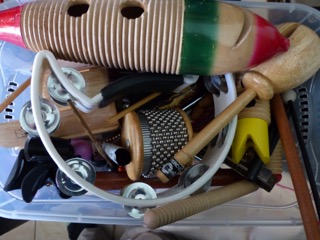 In my office I keep a variety of percussion instruments that can be blown, rattled, squeezed, shaken or struck. Julian, aged ten, who has ADHD and difficulty in sustaining relationships, struggled to engage when he began counselling. Yet he became curious about the instruments. When I invited him to try them, his eyes lit up. Julian grabbed at the devices haphazardly, dropping some in his haste to examine others whilst he worked his way around them all. Aware of his continuing distractedness I decided to meet him where he was energetically. I suggested he quickly play just one note on each instrument and describe in one or two words what the sound was like – e.g. loud/soft, hard/soft, etc. After a brief period of racing between instruments he began to settle, listening intently to the sounds emanating from them. The red concertina enthralled Julian, who discovered he could make rich chords by depressing buttons. During an improvisation Julian accompanied my guitar playing and alternated between making bursts of sound (‘clicks’) and longer, sustained notes, smiling broadly as our sounds overlapped on the latter exercise. The concertina proved to be physically demanding for Julian. The clicks required his compressing swiftly the bellows and pushing his hands together; the sustain sounds required a slower, persistent expanding of the bellows. To hear ‘clicks’ clearly and respond in similar vein requires an ability to listen, focus and cooperate; to explore different ways of contacting and using one’s body. Though Julian found this hard initially, with practice he became more adept. He delighted in making exuberant flurries of sound, discovering that in the clinic setting expression of his boisterousness through music making was welcomed.
In my office I keep a variety of percussion instruments that can be blown, rattled, squeezed, shaken or struck. Julian, aged ten, who has ADHD and difficulty in sustaining relationships, struggled to engage when he began counselling. Yet he became curious about the instruments. When I invited him to try them, his eyes lit up. Julian grabbed at the devices haphazardly, dropping some in his haste to examine others whilst he worked his way around them all. Aware of his continuing distractedness I decided to meet him where he was energetically. I suggested he quickly play just one note on each instrument and describe in one or two words what the sound was like – e.g. loud/soft, hard/soft, etc. After a brief period of racing between instruments he began to settle, listening intently to the sounds emanating from them. The red concertina enthralled Julian, who discovered he could make rich chords by depressing buttons. During an improvisation Julian accompanied my guitar playing and alternated between making bursts of sound (‘clicks’) and longer, sustained notes, smiling broadly as our sounds overlapped on the latter exercise. The concertina proved to be physically demanding for Julian. The clicks required his compressing swiftly the bellows and pushing his hands together; the sustain sounds required a slower, persistent expanding of the bellows. To hear ‘clicks’ clearly and respond in similar vein requires an ability to listen, focus and cooperate; to explore different ways of contacting and using one’s body. Though Julian found this hard initially, with practice he became more adept. He delighted in making exuberant flurries of sound, discovering that in the clinic setting expression of his boisterousness through music making was welcomed.
Music making can sometimes offer a helpful, ‘left-field’ intervention when teenagers and families become locked in circular conflicts. Gavin (17) and his sister Isabelle (15) were referred on account of their rivalrous relationship that sometimes became violent. They came from an articulate family that had spent years in family therapy elsewhere attempting to work through their difficulties without success. Recriminations soared as the family laid into each other again, replaying an old argument. I decided to try another tack.
I invited the family to try a musical experiment involving performing and listening (Oaklander, 2006). Sitting in a circle each selected a percussion instrument from a selection and briefly explored it – triangle, shaker, mouth organ and ukulele. When instructed they closed their eyes and took turns playing solo awhile whilst the others listened. This was difficult. Each family member tended to overplay, merging with each other’s sounds, which annoyed Isabelle. I invited them to repeat the exercise, this time with myself assuming the role of conductor, realising I needed to be actively directive. After a few abortive attempts the group began to listen more carefully, attending to where sounds began and ended, allowing space for gaps. “What are you noticing?”, I asked. “We’re not getting it”, observed Isabelle frustratedly, amid general nodding. I concurred.
“OK – let’s try something else”, I suggested, and instructed them in playing a ‘click piece’ together. This was easier to grasp: Gavin’s toots on recorder were followed by Isabelle’s shaker, then mother’s twang on the zither and father’s thud on the drum. I suggested they pay attention to volume: Stevens suggests that participants attend to the overall sound balance within the room, adjusting their own click to find equal volume and emphasis with other people’s sounds. In other words to develop awareness of the whole field and one’s place within it.
Next I encouraged them to “make the most effective, satisfying click sounds possible” as though aiming at a target. Now each click becoming a moment of full contact. As they mastered this process their energy rose; mischievously each tried to match the others for brevity, ending in a glorious ‘hit and run’ dash of blurted sounds. “How was that?”, I asked. “Now we’re getting it!”, they confirmed, “it’s fun!” When I enquired how long it had been since the family experienced themselves as having fun no one could remember. Often when young persons or families come into therapy their interpersonal relationships have hit rock bottom; one of the tasks of therapy is to engage them in more satisfying constructive activity. Having a good experience in therapy enabled the family to begin a dialogue about how each member could be helped to feel more valued and included.
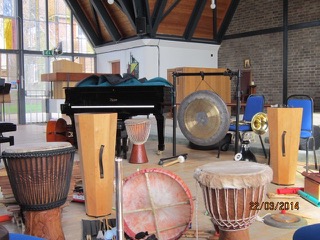 Next session I introduced an improvisation based on making ‘Sustain’ sounds. Each person was instructed to sing or play their instrument for a single exhaled breath length, then inhale and repeat the process. Shorter sounds generated from plucking strings or striking percussion could be repeated via a form of aural ‘scribbling’ (ibid). Working together the family began playing a mixture of sounds that moved from discordant and arrhythmic to concordantly ethereal; mysterious notes on the melodica and cimbala (Polish harp) became figural then merged into ground as pounding drums and reverberating cymbals soared into prominence, then also faded. With each person’s breathing being of a different length the experience was of different sounds meeting across borders, crossing over, fading and raising in a new context. In the subsequent discussion the family compared this to watching fireworks: unforgettable, beautiful, ephemeral, a sense of time standing still, what might essentially be considered a state of ‘flow’, a joyful moment where everything and everyone just fitted (Nietz and Spickard, 1990). The discussions shifted to how members felt when attention shifted away from them to another during the exercise, unusually for them experienced as positive. Uncharacteristically the family sounded like a jazz group lining up to take their solos – with everyone having a chance to star. We moved on to consider parallels in their life outside: what ‘being in the spotlight’ felt like for Gavin and Isabelle, father’s lifelong struggle with shyness, mother’s fear of not pleasing everyone. Increasingly family members showed their ability to communicate honestly and respectfully, treating each other as ‘Thous’ (Buber, 1958).
Next session I introduced an improvisation based on making ‘Sustain’ sounds. Each person was instructed to sing or play their instrument for a single exhaled breath length, then inhale and repeat the process. Shorter sounds generated from plucking strings or striking percussion could be repeated via a form of aural ‘scribbling’ (ibid). Working together the family began playing a mixture of sounds that moved from discordant and arrhythmic to concordantly ethereal; mysterious notes on the melodica and cimbala (Polish harp) became figural then merged into ground as pounding drums and reverberating cymbals soared into prominence, then also faded. With each person’s breathing being of a different length the experience was of different sounds meeting across borders, crossing over, fading and raising in a new context. In the subsequent discussion the family compared this to watching fireworks: unforgettable, beautiful, ephemeral, a sense of time standing still, what might essentially be considered a state of ‘flow’, a joyful moment where everything and everyone just fitted (Nietz and Spickard, 1990). The discussions shifted to how members felt when attention shifted away from them to another during the exercise, unusually for them experienced as positive. Uncharacteristically the family sounded like a jazz group lining up to take their solos – with everyone having a chance to star. We moved on to consider parallels in their life outside: what ‘being in the spotlight’ felt like for Gavin and Isabelle, father’s lifelong struggle with shyness, mother’s fear of not pleasing everyone. Increasingly family members showed their ability to communicate honestly and respectfully, treating each other as ‘Thous’ (Buber, 1958).
Through further musical explorations the family explored other themes of jealousy, loneliness, resentment and finally, love, shifting their interpersonal stuckness, to see and hear each other with greater clarity.
Oaklander’s approach to music-making
Violet Oaklander pioneered using music within Gestalt therapy with children (Oaklander, 2006). Her adaptations of musician Paul Winter’s approach to music making are suitable for working with individuals, families and groups. They can be modified or used alongside other arts modalities to help children explore a range of feelings. The basic schema is as follows:
- Each person selects an instrument
- Client begins playing ‘freestyle’
- Moments later, therapist adds accompaniment
- After a brief duet client stops; therapist continues playing solo
- Client chooses another instrument and joins in again
- Moments later therapist stops; client continues playing alone
- Therapist rejoins client on a new instrument and so on
- Hand signals and repetition help establish the sequence of events, which is carried out without speaking. (pg 211)
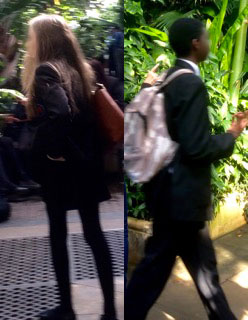 I find this structured approach works well with individuals and with groups where decision-making and interpersonal boundaries seem blurred; also with families who are less ‘psychologically minded’. In the case example of Gavin’s family I initially assumed that members would find it helpful to have a clearly structured task and to have someone else act as conductor. How people respond to the presence or absence of such structure gives useful information that has implications for the course of therapy; just as some children find the prospect of drawing on large paper overwhelming others may find the open-endedness of beginning with a ‘sustain’ type exercise too much to cope with.
I find this structured approach works well with individuals and with groups where decision-making and interpersonal boundaries seem blurred; also with families who are less ‘psychologically minded’. In the case example of Gavin’s family I initially assumed that members would find it helpful to have a clearly structured task and to have someone else act as conductor. How people respond to the presence or absence of such structure gives useful information that has implications for the course of therapy; just as some children find the prospect of drawing on large paper overwhelming others may find the open-endedness of beginning with a ‘sustain’ type exercise too much to cope with.
Troubled children not only experience difficulties in making healthy, satisfying contact, they often lack a good sense of self and have poor self esteem (Oaklander, 2006). Experiencing the music-making process has a positive effect, strengthening the self and contact functions. Singing or playing an instrument is embodied expression: breathing, plucking, blowing or striking is usually involved. For some children making movements whilst producing sound helps loosen up tight musculature (Frohlich, 2009). For hyperactive children music making helps to calm the self and restores focus. Others, including notably children with Williams syndrome (Bellugi, 2001), report a sense of ‘aliveness’. Taking part helps foster organismic self-regulation in all participants – including the therapist! Certain additional benefits may accrue from improving one’s ability to listen and respond to sound. For example research shows that the same neural mechanisms used for establishing eye contact are shared with those required listening to the human voice (Porges, 2005). Anecdotally my clinical experience is that many children who (re)gain facility in using their hearing and vocalising faculties show an increased ability to cope with and utilise gazing.
Rhythm and self-regulation
Humans are hard wired for rhythm: As bipedal mammals we create beats whenever we walk, run or jump (Frohlich, 2009). Merker (2000) has proposed that music evolved through humans’ unique ability to keep time, enabling foot-stomping and synchronised group chorusing. Waving, clapping and shaking involve pulsating rhythms: we use regular whole-body movements in swinging and swimming (Frohlich, 2009). Our limbs move in relation to body rhythms (think of the swaying that accompanies gospel choirs or the enmass ‘Mexican waves’ produced by happy football fans); our circulation and respiration systems also show rhythmicity.
Research suggests that trauma is associated with cardiac arrhythmia (Osborne, 2009). Rhythm is at the heart of self-regulation (Carroll, 2009: personal conversation.) It is the basis of organisation, granting predictability and a schema; it operates at all levels of human engagement:
When we connect to our internal rhythm, we know who we are. How we connect to the rhythm of another defines our relationship with them in that moment.
(Carroll, 2005, p91, italics in text).
Whenever the jazz singer Billie Holiday sang behind the beat, she uniquely altered the structure of the song. To meet this challenge she needed to retain a constant awareness of her own rhythm. Working against the beat she accentuated her phrasing, improvising like an instrument and conveying fresh meaning.* As Carrol (ibid) notes:
As much as we need regularity of rhythm, we also need graded differences, surprises, and new movements: and this is the basis for reorganisation, a development and expansion of the sense of self.
This has implications for the tasks of therapy. Child or adolescent clients need opportunities to practice finding and exploring their ‘flow’ (Csikszentmihalyi, 1990), to fully experience them as having agency within the organism-environment field. Every Gestalt has its own rhythm for completion, as Beisser’s paradoxical theory of change attests. (Beisser, 1970). From our Gestalt theory we are familiar with exploring polarities; exploring a lingering moment of power through a ‘sustain’ (evoked in the emerging guitar solo on ‘All Right Now’) enables us to experience our ability to sustain ourselves, to feel potent. Visiting its polarity, i.e. ‘click’ responses, enables us to experience a different sense of our power, through feeling’ snappy/penetrating or ‘on the ball’.
Exploring arrythmicity with awareness in this way helps us discover our capacity for and relationship to rhythm. In families where differentiation is discouraged and parental control takes precedence it can be hard for children and harder still for separating adolescents to find their own rhythm (McConville, 1995).
Singing
Singing offers a powerful form of relational communicating: songs are lyrical and affect others whether communicating joy, rebellion or yearning (Blend, 2008). Young infants become captivated by the sound of a mother’s lullaby (Panksepp and Trevarthen, 2009) and respond with delight to learning ‘action songs’ that combine melody with words and sequences of bodily activity, e.g. ‘Round and round the garden’. Mother’s repetitions and baby’s anticipation help build the tension: ”one step, two steps,” leads to discharge through mother’s tickling baby accompanied by happy squeals as the ritual is shared (Ekerdal & Merker, 2009). Through learning to manage anticipation and survive the excitement of being tickled (which neurobiologist Jaak Panksepp, 1998, observes we cannot do to ourselves!) the child becomes able to self-regulate. (Carroll, personal conversation, 2009).
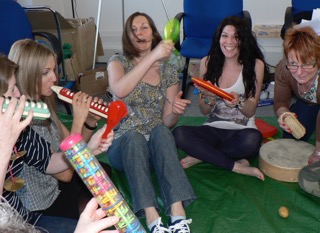 Singing facilitates contact-making and promotes social cohesion (Gregory, 2004). Community singing provides a sense of common purpose: singing together reinforces the sense of expressing a shared ‘truth’ (Ibid). Moving to music often adds to the experience (as happens in gospel singing) whilst the vibration of naturally generated sound within one’s body helps restore organismic self-regulation. Working dialogically with children making sound, the therapist similarly pays attention to flow and its interruptions, to the nature and quality of movement, breathing, singing and conversation. This encounter supports the expression and growth of the self (ibid, Blend, 2005) as the following vignette shows:
Singing facilitates contact-making and promotes social cohesion (Gregory, 2004). Community singing provides a sense of common purpose: singing together reinforces the sense of expressing a shared ‘truth’ (Ibid). Moving to music often adds to the experience (as happens in gospel singing) whilst the vibration of naturally generated sound within one’s body helps restore organismic self-regulation. Working dialogically with children making sound, the therapist similarly pays attention to flow and its interruptions, to the nature and quality of movement, breathing, singing and conversation. This encounter supports the expression and growth of the self (ibid, Blend, 2005) as the following vignette shows:
Julia, aged 15, presented as listless and fearful with doll-like appearance and many phobias. Julia’s mother had been depressed throughout Julia’s early years whilst father retreated into working long hours. Dissatisfied with her highly cosseted lifestyle Julia used therapy to support her during a period of experimentation.
I had discovered that Julia liked to sing and dance though was shy of doing so in the presence of others. Yet another aspect of her longed to be seen, to strive and to perform. In the last century composer Carl Orff devised his ‘Elemental Music’ (Rosch, 2004), an improvised synthesis of music, speech and movement. In similar vein I fashioned simple tunes to phrases (“Yes”,”No”,”I can”,”I want to”,”Get lost”,”If only”), inviting Julia to try these out whilst moving around. Hesitantly she accepted, on condition that I joined in. She sought to cover her embarrassment with self disparaging humour that sometimes gave way to painful introjects –”I should be able to do this – aren’t I just SOOOO PATHETIC?”
“It sounds like that inner critic of yours is back, lashing you again Julia”, I replied, “yet this is really hard for you – you’re moving out of your comfort zone. That takes some courage; it looks a scary place to inhabit right now.”
“Dead right!”, she replied. “O- oh- I’m fading again.”
I invited Julia to find a sound that might fit with her present experience. At first she made a groan, then developed this into a low hiss, and added darting movements. We began circling like snakes, hissing and striking at each other around the room. Catching a glimpse of herself ‘snaking’ in the mirror she laughed and shared her relief at no longer feeling self-conscious nor needing to “fade away” (her words for the dissociating she underwent, as a creative adjustment, when overwhelmed). When I encouraged her to say whom she would most like to strike out at in her real life she shuddered, and spoke with considerable feeling about a relative whose lewd advances had recently left her feeling uncomfortable.
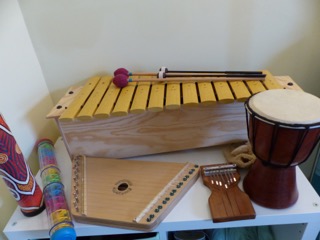 Charlotte Frohlich, writing on the connection between music and dance, suggests that communication, improvisation, pulsation and breathing are all interrelated (Frohlich, 2009). When Julia began communicating non-verbally (hissing) she started a movement that could be developed through our improvising (striking out). As we explored her dance together a joyful rhythmic pulse was set up (swaying) that enabled her to stay embodied rather than dissociative.
Charlotte Frohlich, writing on the connection between music and dance, suggests that communication, improvisation, pulsation and breathing are all interrelated (Frohlich, 2009). When Julia began communicating non-verbally (hissing) she started a movement that could be developed through our improvising (striking out). As we explored her dance together a joyful rhythmic pulse was set up (swaying) that enabled her to stay embodied rather than dissociative.
As Julia continued worked on extending her vocal range she discovered her authentic voice. This enabled her to feel more powerful and to become more assertive. As Gregory notes, the experience of singing enables us to make manageable the discharge of energy previously retroflected during intense experience (Gregory, 2004). When Julia experimented with varying her volume, tempo and voice tones, she found she could live in the present, rather than succumbing to anticipatory anxiety. As she became more confident at living in the moment her phobias began to recede and her sense of self strengthened (ibid). Julia discovered that: “the dance, the co-created Gestalt, can be fun, can be play” (Parlett, 1991).
In my youth, recorded music was often utilised to promote healing (Flackus, 1974); listening to music in class formed part of the school curriculum, though sadly no more. Nowadays we can access a wealth of music easily via our computers. Listening to music combined with autogenics may indeed help regulate hyper-arousal (Butterton, 2008) though such approaches, which privilege verbal responses, may be more suited to adults. The case for working directly with children through music-making is, I feel, stronger. Improvising has immediacy. It offers present-focussed, embodied and relational engagement, free of verbal complexity wherein the instruments can act as part conduit to our personal and interpersonal worlds. One does not need to be a musician to facilitate musical improvisation, as Oaklander’s simple yet effective approach demonstrates.
Facilitators may benefit from acquainting themselves with a variety of sound-making devices, allowing free rein to curiosity and an inclusive attitude (Yontef, 1993) towards whatever music is generated however discordant or unusual. It helps to broaden one’s personal acquaintance of music styles, from afro beats to Messiaen, from rap to zydeco. A willingness to experiment through improvising, switching from accompanying to conducting and back as required is fundamental…
Author’s note: this article first appeared in International Gestalt Journal: Volume 32, Number 2, 2009 (c) Jon Blend
*: the late Amy Winehouse was another exponent of the singing-behind-the-beat style.
